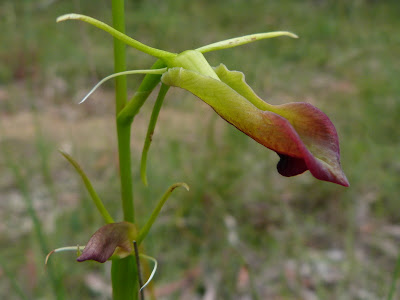Not a lot of orchids flower in our part of the world in mid-summer, but those that do are worth admiring. I'm just back, as I flagged last time, from lower elevation climes near the coast, where one of the stars, in my opinion at least, is the small genus Cryptostylis, known generally as tongue orchids for the usually long and extended labellum. They don't occur here on the highlands, but are reasonably common further east.
I enjoy three species down there most Christmases, and this wasn't an exception.
 |
| Cow Orchid, Cryptostylis subulata.Perhaps not very romantic, but you couldn't really call it anything else... |
 |
| Spotted Tongue Orchid, Cryptostylis leptochila, Fitzroy Falls, Morton National Park. Less common than the other two, in my experience. |
Another genus we associate with mid-summer are the leafless saprophytes (ie taking nutrients from roots of other plants via a fungal association) the hyacinth orchids, Dipodium.
They are found from the coast to the mountains; they can stand a metre tall on a leafless often red-black stem (no need for leaves or chlorophyll if you don't do your own photosynthesising) with up to 50 flowers, so are hard to miss!
 |
| Slender Hyacinth Orchid, Dipodium variegatum, Nowra. |
 |
| Blotched Hyacinth Orchid, Dipodium puntatum, Nowra. |
+Brindies+0110.jpg) |
| Rosy Hyacinth Orchid, Dipodium roseum, Namadgi National Park, Australian Capital Territory. |
Another that I was particularly pleased to see - the first time I've seen it in flower - is the delightful tiny epiphyte known as Myrtle Bells, because in this part of the world it is pretty much limited to the trunks of Grey Myrtle, Backhousia mytrifolia, along creek lines in drier rainforest. These flowers were barely 5mm across (which I hope partly excuses the ordinary photos!) though it had been dry and I gather they can be twice that size.
 |
| Sarcochilus hillii, near Nowra; whole plant (above) to give some idea of it, and a single flower (below). |
Of course there are other orchids around at this time of year (and I'll be going up into the local mountains this summer in the hope of finding more to share with you) but this was pretty much what I saw this time; they made me happy though, and I hope they can do the same for you.
Back Sunday.



1 comment:
Oooooh! These are lovely. I am so envious!
Post a Comment